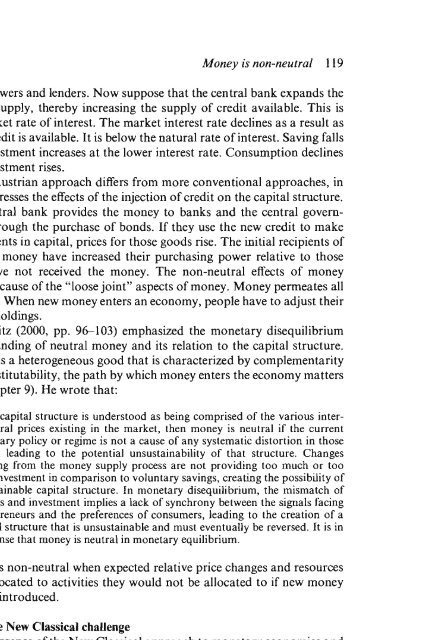Handbook on Contemporary Austrian Economics
Handbook on Contemporary Austrian Economics
Handbook on Contemporary Austrian Economics
Create successful ePaper yourself
Turn your PDF publications into a flip-book with our unique Google optimized e-Paper software.
M<strong>on</strong>ey is n<strong>on</strong>-neutral 119<br />
of borrowers and lenders. Now suppose that the central bank expands the<br />
m<strong>on</strong>ey supply, thereby increasing the supply of credit available. This is<br />
the market rate of interest. The market interest rate declines as a result as<br />
more credit is available. It is below the natural rate of interest. Saving falls<br />
and investment increases at the lower interest rate. C<strong>on</strong>sumpti<strong>on</strong> declines<br />
and investment rises.<br />
The <strong>Austrian</strong> approach differs from more c<strong>on</strong>venti<strong>on</strong>al approaches, in<br />
that it stresses the effects of the injecti<strong>on</strong> of credit <strong>on</strong> the capital structure.<br />
The central bank provides the m<strong>on</strong>ey to banks and the central government<br />
through the purchase of b<strong>on</strong>ds. If they use the new credit to make<br />
investments in capital, prices for those goods rise. The initial recipients of<br />
the new m<strong>on</strong>ey have increased their purchasing power relative to those<br />
who have not received the m<strong>on</strong>ey. The n<strong>on</strong>-neutral effects of m<strong>on</strong>ey<br />
occur because of the "loose joint" aspects of m<strong>on</strong>ey. M<strong>on</strong>ey permeates all<br />
markets. When new m<strong>on</strong>ey enters an ec<strong>on</strong>omy, people have to adjust their<br />
m<strong>on</strong>ey holdings.<br />
Horwitz (2000, pp. 96-103) emphasized the m<strong>on</strong>etary disequilibrium<br />
understanding of neutral m<strong>on</strong>ey and its relati<strong>on</strong> to the capital structure.<br />
Capital is a heterogeneous good that is characterized by complementarity<br />
and substitutability, the path by which m<strong>on</strong>ey enters the ec<strong>on</strong>omy matters<br />
(see Chapter 9). He wrote that:<br />
If the capital structure is understood as being comprised of the various intertemporal<br />
prices existing in the market, then m<strong>on</strong>ey is neutral if the current<br />
m<strong>on</strong>etary policy or regime is not a cause of any systematic distorti<strong>on</strong> in those<br />
prices, leading to the potential un sustain ability of that structure. Changes<br />
deriving from the m<strong>on</strong>ey supply process are not providing too much or too<br />
little investment in comparis<strong>on</strong> to voluntary savings, creating the possibility of<br />
a sustainable capital structure. In m<strong>on</strong>etary disequilibrium, the mismatch of<br />
savings and investment implies a lack of synchr<strong>on</strong>y between the signals facing<br />
entrepreneurs and the preferences of c<strong>on</strong>sumers, leading to the creati<strong>on</strong> of a<br />
capital structure that is unsustainable and must eventually be reversed. It is in<br />
this sense that m<strong>on</strong>ey is neutral in m<strong>on</strong>etary equilibrium.<br />
M<strong>on</strong>ey is n<strong>on</strong>-neutral when expected relative price changes and resources<br />
are reallocated to activities they would not be allocated to if new m<strong>on</strong>ey<br />
was not introduced.<br />
8.5 The New Classical challenge<br />
The emergence of the New Classical approach to m<strong>on</strong>etary ec<strong>on</strong>omics and<br />
macroec<strong>on</strong>omics more generally has greatly reduced the importance of<br />
m<strong>on</strong>ey in explaining the effects of changes in its supply. Their rise to dominance<br />
virtually eliminated any discussi<strong>on</strong> of <strong>Austrian</strong> approaches to n<strong>on</strong>neutral<br />
m<strong>on</strong>ey. Early New Classical models assumed away the sources of

















